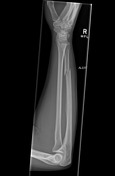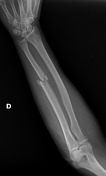Nightstick fracture (ulna)
Updates to Article Attributes
Nightstick fractures are isolated fractures of the ulna, typically transverse and located in the mid-diaphysis and usually resulting from a direct blow. It is a characteristic defensive fracture when the patient tries to ward off an overhead blow from an assailant (or local law enforcement officer) brandishing a bar-like weapon.
This is a defence type-type fracture and cases should prompt concern for a patientspatient's safety, it is rare that an isolated fracture of the ulna can be the result of falling over5. Intimate partner violence amongst other things should be considered in patients where the clinical details do not match the fracture 4,5.
Radiographic features
Radiographs are most often sufficient to diagnose an isolated ulnar shaft fracture.
Plain radiograph
Nondisplaced fractures are much more likely secondary to assault than displaced ones 5.
Treatment and prognosis
Although nightstick fractures are typically closed fractures, they have a higher rate of delayed union or non-union.
History and etymology
Historically this fracture was seen not infrequently due to a strike from a policeman’s baton (known as a nightstick in the USA).
-<p><strong>Nightstick fractures</strong> are isolated fractures of the <a href="/articles/ulna">ulna</a>, typically transverse and located in the mid-diaphysis and usually resulting from a direct blow. It is a characteristic defensive fracture when the patient tries to ward off an overhead blow from an assailant (or local law enforcement officer) brandishing a bar-like weapon.</p><p>This is a defence type fracture and cases should prompt concern for a patients safety, it is rare that an isolated fracture of the ulna can be the result of falling over. <a href="/articles/intimate-partner-violence">Intimate partner violence</a> amongst other things should be considered in patients where the clinical details do not match the fracture <sup>4</sup>.</p><h4>Treatment and prognosis</h4><p>Although nightstick fractures are typically a <a title="Closed fracture" href="/articles/closed-fracture">closed fractures</a>, they have a higher rate of delayed union or <a href="/articles/fracture-non-union-1">non-union</a>.</p><h4>History and etymology</h4><p>Historically this fracture was seen not infrequently due to a strike from a policeman’s baton (known as a nightstick in the USA).</p>- +<p><strong>Nightstick fractures</strong> are isolated fractures of the <a href="/articles/ulna">ulna</a>, typically transverse and located in the mid-diaphysis and usually resulting from a direct blow. It is a characteristic defensive fracture when the patient tries to ward off an overhead blow from an assailant (or local law enforcement officer) brandishing a bar-like weapon.</p><p>This is a defence-type fracture and cases should prompt concern for a patient's safety, it is rare that an isolated fracture of the ulna can be the result of falling over <sup>5</sup>. <a href="/articles/intimate-partner-violence">Intimate partner violence</a> amongst other things should be considered in patients where the clinical details do not match the fracture <sup>4,5</sup>.</p><h4>Radiographic features</h4><p>Radiographs are most often sufficient to diagnose an isolated ulnar shaft fracture.</p><h5>Plain radiograph</h5><p>Nondisplaced fractures are much more likely secondary to assault than displaced ones <sup>5</sup>.</p><h4>Treatment and prognosis</h4><p>Although nightstick fractures are typically <a href="/articles/closed-fracture" title="Closed fracture">closed fractures</a>, they have a higher rate of delayed union or <a href="/articles/fracture-non-union-1">non-union</a>.</p><h4>History and etymology</h4><p>Historically this fracture was seen not infrequently due to a strike from a policeman’s baton (known as a nightstick in the USA).</p>
References changed:
- 5. Khurana B, Sing D, Gujrathi R et al. Recognizing Isolated Ulnar Fractures as Potential Markers for Intimate Partner Violence. Journal of the American College of Radiology. 2021;18(8):1108-17. <a href="https://doi.org/10.1016/j.jacr.2021.03.006">doi:10.1016/j.jacr.2021.03.006</a> - <a href="https://www.ncbi.nlm.nih.gov/pubmed/33823142">Pubmed</a>
Image 1 Photo ( update )

Image 2 X-ray (Frontal) ( update )

Image 3 X-ray (Frontal) ( update )

Image 4 X-ray (AP) ( update )

Image 5 X-ray (Frontal) ( update )

Image 6 X-ray (Frontal) ( create )

Image 7 X-ray (Lateral) ( update )

Image 8 X-ray (Frontal) ( update )

Image 10 X-ray (Frontal) ( update )

Image 11 X-ray ( update )








 Unable to process the form. Check for errors and try again.
Unable to process the form. Check for errors and try again.